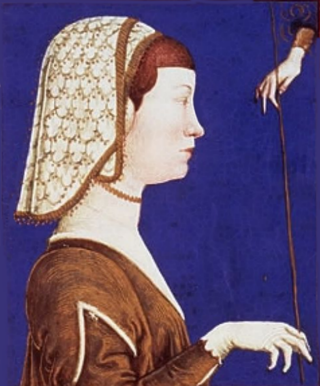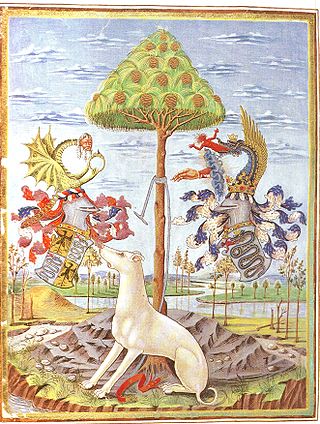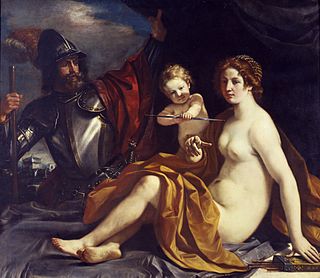
Isabella d'Este was the Marchioness of Mantua and one of the leading women of the Italian Renaissance as a major cultural and political figure.

The House of Este is a European dynasty of North Italian origin whose members ruled parts of Italy and Germany for many centuries.

Palazzo Schifanoia is a Renaissance palace in Ferrara, Emilia-Romagna (Italy) built for the Este family. The name "Schifanoia" is thought to originate from "schivar la noia" meaning literally to "escape from boredom" which describes accurately the original intention of the palazzo and the other villas in close proximity where the Este court relaxed. The highlights of its decorations are the allegorical frescoes with details in tempera by or after Francesco del Cossa and Cosmè Tura, executed ca 1469–70, a unique survival of their time.

The Castello Estense or castello di San Michele is a moated medieval castle in the center of Ferrara, northern Italy. It consists of a large block with four corner towers.

Ercole I d'Este KG was Duke of Ferrara from 1471 until 1505. He was a member of the House of Este. He was nicknamed North Wind and The Diamond.

Eleanor of Naples was Duchess of Ferrara by marriage to Ercole I d'Este. She was the first duchess of Ferrara, and mother of many famous Renaissance figures. She was a well known political figure, and served as regent of Ferrara during the absence of her spouse.

Girolamo Graziani was an Italian poet and diplomat.

The Biblioteca Estense, was the family library of the marquises and dukes of the House of Este. The exact date of the library's birth is still under speculation, however it is known for certain that the library was in use during the fourteenth century. Whilst it was greatly enriched during the Renaissance years in Ferrara, the library was concretely established in Modena in the beginning of the seventeenth century. It is known as one of the most important libraries in Italy. The library is located, along with the Galleria Estense directly below its collection of artworks, in the Palazzo dei Musei in Modena.

The Galleria Estense is an art gallery in the heart of Modena, centred around the collection of the d’Este family: rulers of Modena, Reggio and Ferrara from 1289 to 1796. Located on the top floor of the Palazzo dei Musei, on the St. Augustine square, the museum showcases a vast array of works ranging from fresco and oil painting to marble, polychrome and terracotta sculpture; musical instruments; numismatics; curios and decorative antiques.

Taddeo Crivelli, also known as Taddeo da Ferrara, was an Italian painter of illuminated manuscripts. He is considered one of the foremost 15th-century illuminators of the Ferrara school, and also has the distinction of being the probable engraver of the first book illustrated with maps, which was also the first book using engraving.
Sergio Zanni is an Italian painter and sculptor. After obtaining the Diploma at the Institute of Arts 'Dosso Dossi' in Ferrara, Italy, he graduated from the Academy of Arts in Bologna. He taught in the Institute of Arts 'Dosso Dossi' until 1995. For his research in sculpturing he utilized backed clay and, successively, lighter material for sculptures of large dimensions.
The Modena Codex is an early fifteenth-century Italian manuscript of medieval music. The manuscript is one of the most important sources of the ars subtilior style of music. It is held in the Biblioteca Estense library in Modena.

The Bible of Borso d'Este is a two-volume manuscript. The illuminated miniatures, work of Taddeo Crivelli and others, were executed between 1455 and 1461. The work is held in the Biblioteca Estense di Modena.
The following is a timeline of the history of the city of Modena in the Emilia-Romagna region of Italy.
The Gallerie Estensi is a network of three museums and a library, bringing together the collective fruits of artistic production from Ferrara, Modena and Sassuolo in the Emilia-Romagna region of Northern Italy. The galleries aim to preserve the historic heritage left by the influential House of Este, with a focus on relating their noble past to the local communities at each site.

The Pinacotecta Nazionale is an art gallery in Ferrara, Emilia-Romagna, Italy. It is located on the piano nobile of the Palazzo dei Diamanti, a work of Renaissance architecture by Biagio Rossetti, commissioned by Leonello d’Este in 1447. Not to be confused with the Civic Museum on the lower floor, which has hosted temporary exhibitions of contemporary art since 1992, the Pinacoteca houses a collection of paintings by the Ferrarese School dating from the thirteenth to the eighteenth centuries. It was founded in 1836 by the Municipality of Ferrara after Napoleon's widespread dissolution of churches threatened the protection of important public artworks. The gallery is formed as much around notable northern Italian painters as it is around the exquisite interior decoration of the palace itself, together with remnants of frescoes from local churches and later acquisitions from the Sacrati Strozzi collection.

The Estense Lapidary Museum is a lapidarium-museum in Modena, Italy, located around the interior quadrangle of the Palazzo dei Musei's ground floor. It is owned by the province of Modena and the Gallerie Estensi. As the first public museum to be commissioned by the Duke Francesco IV d'Este upon his re-entry into Modena in 1814, it stands as a symbol of the collaboration between church, state and nobility. It also marks a new direction for the city of Modena, one recognising its rich historical identity.

Venus, Cupid and Mars is a 1633 oil-on-canvas painting by the Italian Baroque painter Guercino, commissioned by Francesco I d'Este for his Ducal Palace of Sassuolo around 1632–1633, when the artist was in that city to paint portraits of the d'Este family. It is now in the Galleria Estense in Modena.

The ‘‘‘Ducal Palace of Rivalta’’’ was a baroque palace in Rivalta, just south of Reggio Emilia, Itay. The palace and its park were inspired by the Palace of Versailles. Until 1796, it served as a residence of the dukes of Modena from the House of Este, after which it fell in disrepair. Today, only the southern wing remains.
















